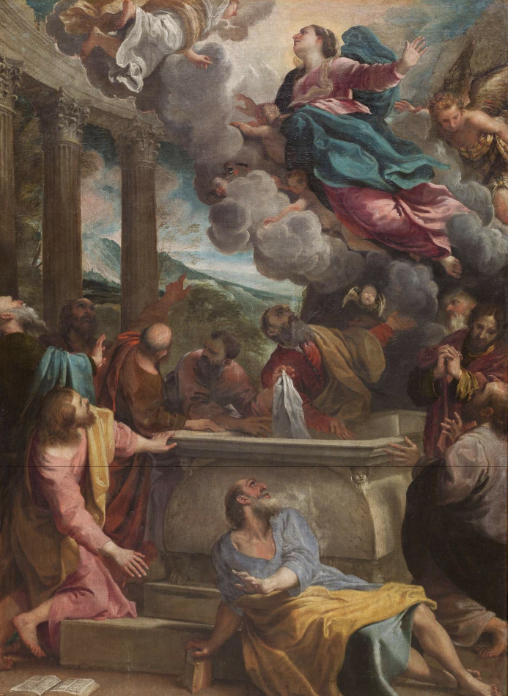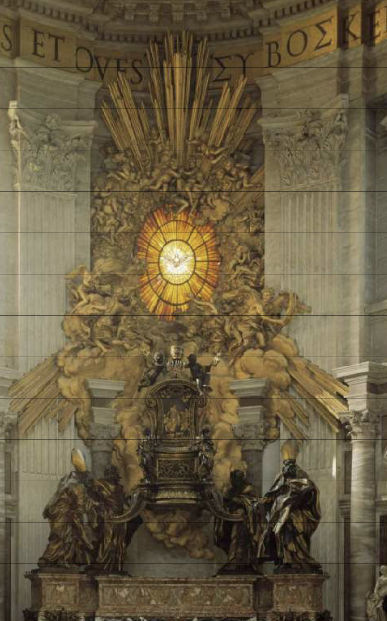Baroque
1/24
There's no tags or description
Looks like no tags are added yet.
Name | Mastery | Learn | Test | Matching | Spaced |
|---|
No study sessions yet.
25 Terms
What did Mannerism mark?
the end of the Renaissance
Baroque time
early 17th century
How did Baroque art emerge? Who founded an institution?
reacting against the complexity and ambiguity of Mannerism
Carracci founded an academy in Bologna that shaped Baroque style
What occurred for the Reformation and Luther in 1517?
Luther posts 95 Theses on the door of the Castle Church in Wittenburg, Germany on October 31
this began protestant reformation
What was the counter-Reformation?
1545-1563
Council of Trent begins
Catholic church responds to Protestant challenges and reform its own practices

Annibale Carracci, The Assumption of the Virgin, 1588-1590. Oil on canvas.
Virgin Mary ascending to Heaven
neoclassical
chiaroscuro
natural and architectural background
movement, dynamism
diagonals
elipses/concentric circles
facial expressions, drama, gestures
chaotic
vivid colours
Baroque integrates movement into religious scenes
How did Baroque differ from High Renaissance?
symmetrical, ordered (Mary along central perpendicular axis) vs. diagonals and chaos (Mary on a diagonal)
stability vs. dynamism
Who was Caravaggio in terms of style?
Baroque artist
focused on emotional intensity and dramatic compositions
striking realistic style
rawness and realism
focuses on human condition
unflattering realism
likeness over idealism
he would use ordinary models (himself, people from streets of Rome)

Caravaggio, Judith Beheading Holofernes, c.1598-1599 or 1602. Oil on canvas.
emotionally intense
Holofernes faces is contorted in shock
Emphasis on the process and Judith performing that action
instantaneous moment
blood pouring out but Holofernes remains alive for a split second
intimate background and scene with few figures
light is a major communication device
highlights figures faces and expressions

Why does the full piece represent?
intermediality
architecture and sculpture merge to make intermedial artwork
showcases Baroque’s integration of multiple arts to create whole pieces
intersections between medias and how they influence each other
What was Bernini’s role in the plan of Saint Peters Basilica?
in 1629, made official architect
worked on existing spaces and changed aspects

What did he incorporate here?
secondary reliquary framed with complex sculptural elements
ornamental framing
dove coming from window directly (foreshortened dove)
architect integrates sculptural elements with architecture
engulfed by sculpted figures
intermediality
physical expression to light

Michelangelo Buonarroti, New Saint Peter’s, 1546
two outstretched arms of colonnades to welcome pilgrims and worshippers
look like Greek columns or temples multiplied dozens of times
taking something static and introducing dynamism
equilateral/greek cross plan type
Bernini was a master of controlling space
Baroque audiences are expected and compelled to move and the piazza guides them through spaces in predetermined steps
architecture lures you, pushes you forward, guides you through a series of steps almost
moving emotionally and physically
swept up in circular dynamics like a vortex
guiding through experience
How did Baroque art serve as propaganda for the counter-Reformation?
Baroque is reaction to reformation and part of counter reformation effects of Catholicism
Catholicism is under threat of nepotism and rejection of institution of papery
Need to win votes back form the people
Baroque art gets at the senses to immersify you
Who was the leader during 17th century France?
King Louis XIV
absolutist leader
“L’État c’est moi”
he embodies the state
What was King Louis XIV reign like?
absolutist rule
Sun King
cared about the arts
transformed the Palace of Versailles
What was the style of the French gardens?
landscape design emerges
overgroomed, geometricized, separating into quadrants
everything organized and orderly
hedges groomed
allegorical references to Sun King

Explain + Why add mirrors?
Hall of Mirrors, Palace of Versailles, Architect Jules Hardouin-Mansart and artist Charles Le Brun, 1678-1684.
builds on Italian Baroque principles
gilded surfaces
shift from religious to secular/political themes to glorify his authority
added reflective surfaces/mirrors to the Baroque vocabulary
brighten the space
visually widen the gallery
amplify natural light
multiplying images of the elites and the Sun King
multiplying the opulent decor, crystal chandeliers
reflects Sun King’s desire to extend his power beyond the state and into the realm of the arts
What was the French Academy?
King Louis XIV, John Baptiste Colbert and Charles Le Brun
founded the royal academy of Painting and Sculpture in 1648
major institution for systemizing knowledge
royal arts training institution
political and financial support
high standards for training
What did the French academy mean for artists?
artists were under control of the state
subservient to the political goals of the state
in exchange for career opportunities, you would agree with the state
What were the Salons (Parisian salons)?
important exhibitions for the arts
informal gatherings for intellectual and social exchange
solidified France as the centre of arts
Recap: Why did the Baroque movement emerge?
in response for the need of the Catholic church to reinstate its influence during the Protestant reformation
a way of reclaiming their followers
moved away from elitism and complexity of Mannerism
Baroque art went for a style that was more direct and compelling for the people
Recap: What are the main features of Baroque art?
accurate anatomy
shown in dramatic lighting, chiaroscuro, gestures, facial expressions
dramatic
power and legible narrative
Recap: What was the point of clear and dramatic Baroque art?
connected on a deeper, emotional level
solicits feelings of devotions and passion more easily
emotion of art needs to be loud, intense and clear
Recap: How did the Sun King use Baroque art?
mobilized the visual language of the Baroque style to sustain his absolutist rule